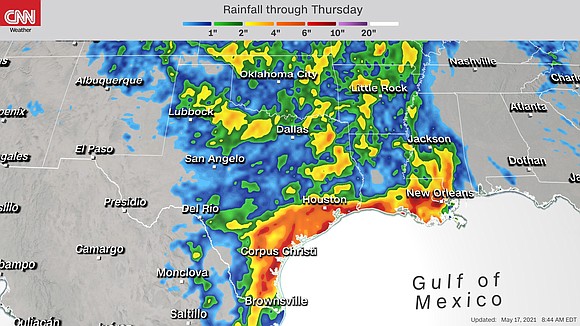Baseball-sized hail threatens Texas again as flood risk increases
CNN/Stylemagazine.com Newswire | 5/17/2021, 3:05 p.m.

Originally Published: 17 MAY 21 10:41 ET
Updated: 17 MAY 21 10:49 ET
By Jackson Dill and Jennifer Gray, CNN
(CNN) -- An outbreak of severe storms will threaten over 33 million people in the southern Plains on Monday, while the risk for flash flooding ramps up Tuesday and Wednesday.
Hail is the greatest risk associated with today's storms in Texas. "Destructive giant hail is possible, if not likely," according to the National Weather Service (NWS) office in Midland, Texas.
Hail as large as baseballs could fall on a state that has already witnessed damaging hail events within the past month.
Check your local forecast >>>
Severe hail and damaging winds
A level 4 out of 5, "moderate" risk for severe weather is in place for parts of West Texas, including Abilene and Lubbock. This is the region at most risk for severe hail, but that threat spans from Colorado to Kansas and through coastal sections of Texas and Louisiana. Cities including Dallas, Fort Worth, Oklahoma City, Denver, Houston, Amarillo and San Antonio are included in the threat zone into Monday night.
Showers and thunderstorms were sweeping across northeastern portions of Texas this morning, bringing heavy rain and frequent lightning, but severe weather is not a major concern with this round of storms.
That will change beginning Monday afternoon, however, as scattered thunderstorms rapidly form over portions of West Texas and eastern New Mexico and Colorado. This is where the moist, humid air from the Gulf of Mexico meets the very dry air from the desert Southwest.
These storms will be responsible for the large hail but there is also a risk of tornadoes. These storms, especially in the first few hours of their formation, will be supercells. This type of storm spins and can sometimes produce tornadoes.
Tonight, these supercell thunderstorms are expected to evolve into a line of storms pushing east across much of Oklahoma and northern Texas. This line will need to be watched for damaging, straight-line winds, with gusts of up to 60-70 mph. Storms will also be possible further south into central Texas.
This is an overnight threat, so it is important to have weather alerts set on your phone in case any dangerous weather moves through your town. It's not until Tuesday morning when this first round of storms will weaken once it reaches Arkansas.
Severe threat continues much of this week
During the early morning hours of Tuesday, a secondary round of thunderstorms is expected to develop across west-central Texas, tracking east while intensifying. This will put central and northeastern parts of Texas at risk for strong storms through Tuesday afternoon. Large hail and damaging winds will be possible with these storms.
Scattered thunderstorms are possible across the remainder of the southern Plains on Tuesday afternoon before a potential third round of intense thunderstorms develops Tuesday evening across central Texas and Oklahoma and continuing into Tuesday night.
The exact location and intensity of these storms is uncertain since this forecast depends on what happens with Monday's storms. Cities including Dallas, Fort Worth, Oklahoma City and Austin will need to be on the lookout regardless.
The weather pattern fueling these days of severe weather will be rather stuck, so additional thunderstorms, some of which could be severe, will continue to threaten the southern Plains much of this week.
11 million face flooding risk
Flooding will increasingly be a concern through portions of the Deep South this week. More than 11 million people are currently under flood alerts from the hill country of Texas through the Dallas metroplex and northward to central Oklahoma.
"Flash flooding will continue to be an issue, as heavy rainfall is anticipated," the National Weather Service office in Fort Worth, Texas, warned. "Parts of Central Texas and the Brazos Valley potentially receiving an additional 5 to 7 inches of rain. Locally higher amounts near 8 to 10 inches or greater will be possible across much of North and Central Texas."
Southerly winds on the south side of a frontal boundary will usher in an abundance of tropical moisture through the week, inundating these areas with consistent rainfall and the potential for flooding. In addition many of the storms that will be firing up will be slow-movers, making risk of flooding more severe.
Several rivers and creeks are already at at moderate flood stage, with several experiencing rapid rise. A location along the Sabine River, just Northeast of Dallas, saw a 12-foot rise in less than 24 hours -- and this was the second time it's happened in less than a week.
The heaviest rain is forecast for Tuesday and Wednesday, where there is a level 3 out of 4 for the risk for flash flooding. This includes Dallas, San Antonio, Austin and Houston. Several locations in Texas could see more than 5 inches of rain.
The biggest forecasting challenge is determining where the heaviest rain will fall. "It seems pretty safe to say that somebody, somewhere in the eastern half of Texas is going to get slammed with a lot of rain," said the National Weather Service office in Houston.
"The potential for minor flooding due to slow-moving storms producing heavy to torrential rainfall is also possible, though knowing an exact location for it is still hard to tell."




